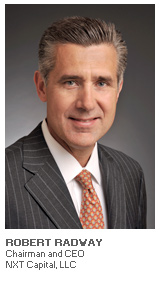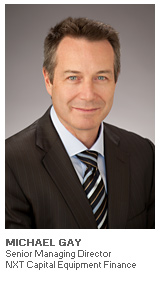
Self-possessed and assured, Robert Radway, President and CEO of NXT Capital, exhibits the traits of a steady-handed captain in command of his vessel. And to be sure, as a 20-plus year veteran in the commercial finance industry, Radway has seen his share of turbulence as well as tranquility in the market. When his most current craft – in this case, NXT Capital – appeared on the scene a few years back, it happened with little fanfare. Nevertheless, the Chicago-based commercial finance company has been steadily pursuing its mission: to serve an underserved market with a broad array of financial products.
To begin with, we asked Radway to share a bit about the formation of NXT Capital. He says, “I would best describe NXT as the next iteration of a business that we started first at Heller Financial and then again at Merrill Lynch Capital, both of which were sold to GE Capital. It’s a business that we’ve been in for a long time and NXT is simply a different brand. But in terms of its management team, strategy and market focus, NXT is really a continuation of what we did at Merrill Lynch Capital.”

Radway notes that NXT hit the scene in 2010 backed with $300 million from Stone Point Capital, a Greenwich, CT-based private equity firm and another $300 million in leverage from Wells Fargo. Radway explains, “Today, we’ve expanded the capital base to $850 million and our debt financing facilities to almost $1.8 billion. We’ve completed two CLO transactions involving our Corporate Finance segment totaling $650 million. And we’ve coupled our balance sheet and our lending capabilities with several asset management mandates from institutional investors. These programs have grown to a little more than $1.1 billion of committed capital. So we’ve had a very rapid evolution from a funding standpoint and we’ve been able to establish NXT as a very successful player in the core markets that we focus on.”
Today, NXT is a 90-person strong operation and its largest segments are its Corporate Finance and Commercial Real Estate businesses led by John Finnerty and co-heads Craig Andreen and Kevin Rostowsky, respectively. Radway continues, “Our more recent additions include our venture finance platform led by Jan Haas. Jan and his team provide senior and subordinated debt to venture capital backed companies. And of course, there’s our latest expansion into the equipment finance space, which is led by Mike Gay.”
Understandably proud of NXT’s growth, Radway sums it up as follows: “We continue growing both head count and balance sheet and I think we’ve become – perhaps not to everyone, but to many – a recognized name in middle-market commercial finance.”
And while the equipment finance space as a whole hasn’t been particularly vibrant in recent times, Radway nonetheless sees an opportunity to fulfill its mission of serving an underserved segment of the market. “As we look at equipment finance, the ongoing trend for the past decade or so has been that banks have evolved to serving investment grade or near investment grade segments of the market. They have moved away from the segments that have traditionally been the focus of commercial finance companies like Heller Financial, Merrill Lynch Capital and other non-bank finance companies that have engaged in this business.”
And that separation, Radway notes, has become more pronounced since the credit crisis. He states, “Overall, the trends are fairly flat in terms of both CAPEX and the financing of equipment across the U.S. economy, but there are pockets of demand. And those exist primarily in the below investment grade arena that’s still underserved.” That segment of the market, he points out, has been the traditional domain of finance companies like NXT.
Equipment Finance – NXT’s Next Step
Michael Gay, whose appointment was announced in early April, joined the ranks at NXT Capital from Banc of America Leasing‘s Capital Markets group. I asked Gay to explain what spurred the career move. He says, “It was two-fold really … the growing strength of the NXT brand and the pressing need to fill a void in the equipment finance marketplace. That combination was incredibly attractive along with NXT’s ability to raise capital, which is something you obviously need to serve this part of the market.”

As for the specifics, both Radway and Gay, expect that NXT Capital will effectively execute deals in the $2 million to $20 million ticket-size range. Gay explains, “As Robert indicated, we’ll focus on opportunities in the sub investment grade space, especially with larger companies in which we can get a bit more visibility into their financial statements and balance sheets.”
In addition, Gay emphasizes this group bills itself as a generalist. “We aren’t trying to be niche-oriented. We have the expertise to underwrite across a wide spectrum of companies and different collateral types. We really understand the needs of these clients and how we can structure attractive solutions for their equipment demands.”
As far as the whole of NXT Capital, Radway puts the launching of the equipment finance group into perspective. He notes, “In terms of our expectations, this is a decent but modest-sized opportunity that fits in well within NXT’s strategy as an emerging and growing commercial finance business. We clearly have the funding and the balance sheet to engage in this business. But, in and of itself, this doesn’t represent a dramatic shift for NXT. It’s a complementary activity – one that our team has been engaged in for almost 20 years now.”
Gay, whose resume includes the likes of Key Equipment Finance, GE Capital and Tokai (now De Lage Landen), is joined by seven other industry professionals. “Cliff Lehman and I started this business back in January and we’re based out of the San Francisco Bay area. Since then, we’ve brought on an indirect originations manager to lead that sales effort, a West Coast originator here with us in Walnut Creek and two credit managers. We also have legal counsel on staff and our asset manager who is based in the Chicago area.”
For both Gay and Radway and their view of the available opportunities in the segment this group has been assembled to serve; eight, most likely, is not enough. Gay expects to hire two more originators this year – one in in the Chicago area and the other probably in Texas. “As we progress through 2013 and into 2014, I foresee us taking our origination effort to a national footprint with a total of five to six originators situated in key geographic locations like the Northeast and the Southeast.”
All that, Gay notes, is in the future. As for the present, he says the reception to this new player has been very good with a “fairly healthy level of deal flow, particularly through the indirect channel.”
CAPEX Expansion – Perhaps Not Today, But Soon
In terms of what’s to come, both Radway and Gay offer their take on what the future likely holds for the equipment finance industry as a whole. Radway says, “We’ve certainly been in a ‘wait and see’ pattern for quite some time in which companies are deferring capital investments. At some point – and I think that’s going to be relatively soon – we going to see the need to engage in an overall CAPEX level to address deferred investment in productive capacity. And whether that happens this year, time will tell. But if you look at the level of activity that we’ve experienced in the four years since the recession, and compare that to more normalized levels of capital expenditures, we ought to see a pick up fairly soon.”
Gay agrees. “Obviously the economy has flattened out, but I think that between the replacement cycle and the firming of the economy, both factors could lead to some sustained improvement in terms of CAPEX spending.”
As Radway aptly points out, time will indeed tell. But for now, he views the new venture into equipment finance as a natural extension of a middle-market oriented commercial finance company. He adds, “It makes a whole lot of sense for us and we expect NXT Equipment Finance to be a very successful component of the platform.”
For Gay, whose career has afforded him broad exposure to the many facets of the industry, the opportunities are there for the taking. “It’s good to be back in this space [the middle-market] again. As a team, I look forward to applying our collective experience to a part of the market that has experienced a void for such a long time. It’s not only about building a nice business; it’s about serving a vital need in the economy.”